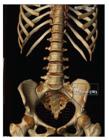OBJECTIVES:
The recent advancements in spine fixation aid in the treatment of complex spinal pathologies. Both the iliac screw (IS) and the S2-alar-iliac (S2AI) screw provide adequate stability in the fixation of complex lumbosacral spine pathologies, leading to a significant increased rate of using these techniques in the daily practice of the spine surgeons. This study aims to analyze, describe, and compare the insertion and positioning parameters of the S2AI screw and IS techniques in children without spinal deformities.
METHODS:
An observational retrospective study was conducted at a university hospital in 2018, with 25 computed tomography (CT) images selected continuously. Mann-Whitney-Shapiro-Wilk tests were performed. The reliability of the data was assessed using the intraclass correlation. The data were stratified by age group only for Pearson’s correlation analysis.
RESULTS:
The mean age was 11.7 years (4.5 SD). The mean IS length was 106.63 mm (4.59 SD). The mean length of the S2AI screw was 104.13 mm (4.22 SD). The mean skin distance from the IS entry point was 28.13 mm (4.27 SD) and that for the S2AI screw was 39.96 mm (4.54 SD).
CONCLUSIONS:
Through CT, the S2AI screw trajectory was observed to have a greater bone thickness and skin distance than the IS. There was a linear correlation between age and screw length for both techniques. A similar relationship was observed between skin distance and age for the S2AI screw technique. In children, the S2AI screw technique presents advantages such as greater cutaneous coverage and implant thickness than the IS technique.
S2AI; Iliac Screw; Spine Surgery; Pelvic Parameters

 Thumbnail
Thumbnail
 Thumbnail
Thumbnail
 Thumbnail
Thumbnail
 Thumbnail
Thumbnail
 Thumbnail
Thumbnail




